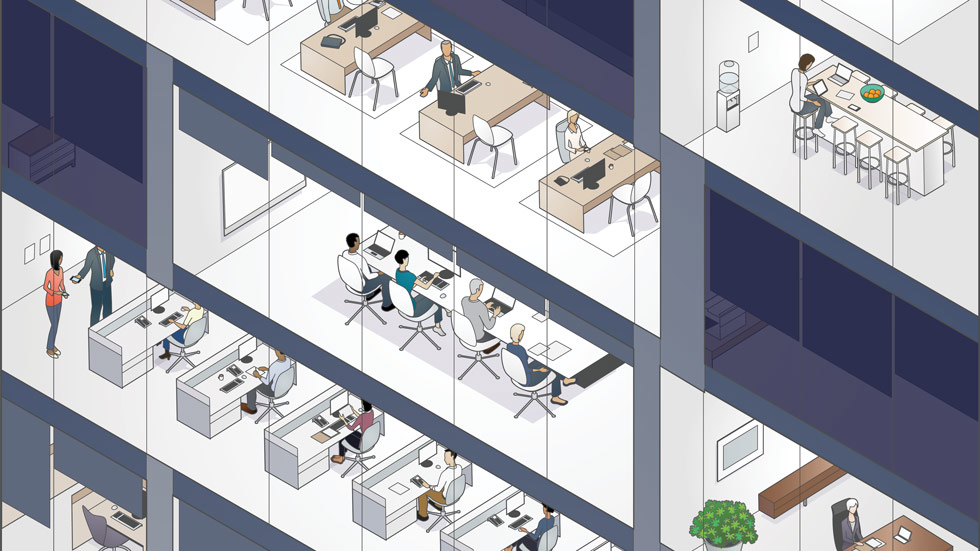Companies realize that the health of their buildings plays a key role in the viability of their business.
One of the many trends accelerated by COVID-19 has been the increased attention given to the quality of indoor environments and how the buildings we inhabit can help or hinder our daily health and performance, says Joe Allen, head of the Healthy Buildings program at the Harvard T.H. Chan School of Public Health.
For decades, the notion that the nation’s buildings should work to bolster occupant health took a back seat to focusing on a building’s energy consumption and its ability to simply avoid disease transmission, Allen says. While priorities had started to shift in recent years, it has taken COVID-19 to fast track the process, he adds.
Companies are now starting to realize, Allen says, that the health of their buildings plays a key role in the viability of their business.
“We’ve seen an explosion of companies rethinking their building strategies and their design strategies and how they monitor the health of the building,” Allen says. “Every CEO is now fully aware that building performance is determining if they can even get back into their building at some point. Or if their employees will even be willing to go back,” he adds.
Allen, co-author of Healthy Buildings: How Indoor Spaces Drive Performance and Productivity, notes that this time last year he could have named every company and researcher active in the healthy building arena. That is no longer the case.
“Everyone in the world is now thinking about indoor environments and how they can make us sick or keep us well. And so, expectations are changing accordingly, as they should,” he says.
Allen worked closely with Boston Properties, Inc.’s (NYSE: BXP) Health Security Task Force, created in the early days of the pandemic, to review and guide the office REIT’s cleaning and air and water quality practices. He says many leading companies have realized they have a knowledge gap when it comes to indoor environmental best practices.
“The really good leaders have their eye on what comes next. Of course, they’re dealing with the here and now of the current crisis, but they’re also thinking about post-COVID and what investments they should make now that pay dividends or continue to pay dividends well after COVID has gone,” Allen says.
Business Argument
Allen points out that the business argument for healthy buildings existed pre-COVID. Since the start of the pandemic, however, it has become “completely obvious that there’s no alternative.”
Some of the reasons why it has taken until now to change that focus has been the misperception that healthy buildings are expensive. “I’d argue that the opposite is true. Sick buildings are expensive,” Allen says. Failure to address a building’s internal environment influences a company’s brand, business, as well as the ability to attract and retain top talent, he states.
Another misperception, according to Allen, is that only new buildings can be healthy. “The reality is that any building can be a healthy building. Every action you take, even incrementally, will provide a benefit. So it’s a mindset shift that needs to occur,” he says.
That mindset shift has been decades in the making. Allen explains that much of what we are living with in buildings today stems from decisions made in the 1970s amid the global energy crisis. At that time, he says, building codes were changed to be almost exclusively focused on energy consumption and less around human health, comfort, and productivity.
“We started tightening up our building envelopes and really choking off the air supply in our buildings, even though we had evidence at the time that higher ventilation rates were associated with better health outcomes,” Allen says. The energy conversation was detached from the health conversation, he says, and shortly thereafter the phrase ‘sick building syndrome’ began to appear in response to the buildup of indoor pollutants.
Since that time, minimum based standards for buildings have been set that aren’t about optimizing human health. “They follow an old paradigm and definition of health that is around disease avoidance,” Allen says.
Nine Foundations
Allen’s book states that the nine foundations for a healthy building focus on: ventilation; air quality; thermal health; moisture; dusts and pests; safety and security; water quality; lighting and views; and noise. In all these areas, “we’re falling very short,” he says.
Allen, and co-author John Macomber of the Harvard Business School, explain how building performance drives human performance, which ultimately drives business performance.
“You can make the connection all the way through these optimized indoor environments, where people actually perform better in terms of decision-making performance. They have better cognitive function. They perform better on creativity tests. They’re more alert during the day,” Allen says.
The benefits of improved building performance are “massive,” Allen says, because now human health and performance are being integrated into the cost benefit analysis, whereas before they were considered simply as costs.
And while there are many priorities when it comes to improving the indoor environment, Allen says the most immediate one to tackle today is ventilation, given that “current minimum standards are not enough.”
Companies are finding that “maybe there’s not the ability to do anything differently with their existing systems because they were sized incorrectly from the beginning, or there was no capacity built in to respond dynamically to any challenge,” he says.
Looking Ahead
With the gradual return to office life, Allen says one of the key topics of discussion is open floor plans and expectations about occupant density. “What is the average worker going to feel comfortable with in a commercial building?” he says.
The role of infectious disease transmission beyond COVID will be front and center on the minds of people for the foreseeable future, Allen believes. “This will pervade and influence decisions for many years to come in schools and offices and in the residential sector too,” he says.
